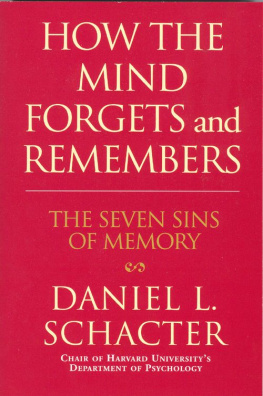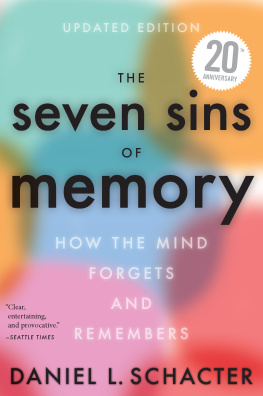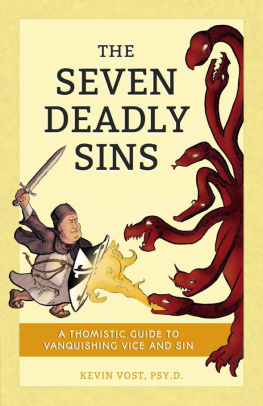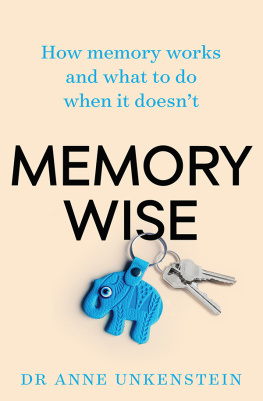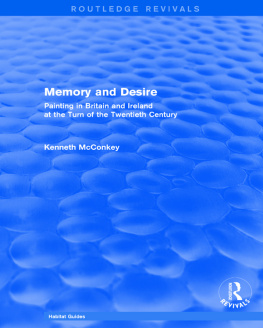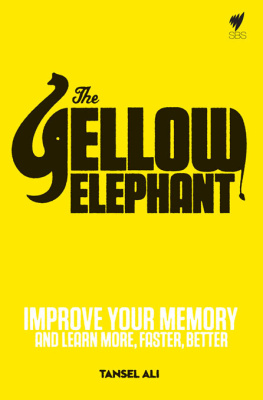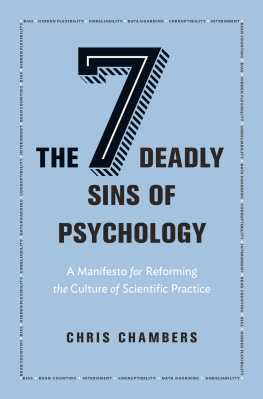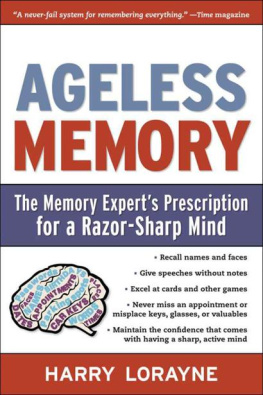Excerpt from Almost No Memory by Lydia Davis. Copyright 1997 by Lydia Davis, Reprinted by permission Farrar, Straus and Giroux, LLC.
The Way We Were, Words by Alan and Marilyn Bergman, Music by Marvin Hamlisch, 1973 Colgems-EMI Music, Inc. All Rights Reserved, International Copyright Secured, Used by Permission.
I Remeber It Well by Alan Jay Lerner and Frederick Loewe, 1957 (Renewed) Alan Jay Lerner and Frederick Loewe, Chappell & Co. owner of publication and allied rights throughout the World, All Rights Reserved, Used by Permission, Warner Bros. Publications U.S. Inc.,Miami, FL 33014.
Figures 1.1 and 1.2: Brain, Mind and Behaviour, Second Edition by Floyd E. Bloom and Arlyne Lazerson 1988 by W. H. Freeman and Company. Used with permission.
Figure 4.1: Reproduced from Figure 1 (p. 162) in Mark Tippens Reinitz, Joseph Morrissey, and Jonathan Demb, Role of attention in face encoding, Journal of Experimental Psychology: Learning,Memory, and Cognition, 1994, 20, 161168. Copyright American Psychological Association.
For my family:
S USAN, H ANNAH, AND E MILY
Contents
It sometimes seems unfair that a book bears only an authors name, because a number of people are responsible, directly or indirectly, for its conception , development, and production. This book is no exception. Ive had the good fortune to consult with many colleagues and students about the topics in these pages too many to thank individually. I hope that you know who you are, and realize that I greatly value your input. I am especially thankful to the members of my laboratory during the past few years; your feedback and ideas have been invaluable for this book and all of my other scientific endeavors.
I owe a special debt to those who have taken the time to read and comment on the manuscript. Moshe Bar, Chad Dodson, Marc Hauser, Lael Schooler, David Sherry, and Gabriella Vigliocco provided incisive feedback on specific chapters which helped me to rethink some important issues and saved me from a variety of oversights and errors. Randy Buckner, Wilma Koutstaal, Richard McNally, and Anthony Wagner read the entire manuscript , coming up with many helpful suggestions and constructive criticisms that have improved the final product considerably. Several of my research assistants Steve Prince, Carrie Racine, and Danielle Unger have helped me in ways too numerous to list; I want them to know how much I value their time and effort.
Laura van Dam, my editor at Houghton Mifflin, supported the book enthusiastically and provided insightful comments on several drafts of the evolving manuscript. Her keen eye for both style and substance helped me to improve the final product immensely. My agent, Susan Rabiner, lent her wisdom and energy to this project, and I appreciate both.
I began The Seven Sins of Memory during a sabbatical year that was supported by a John Simon Guggenheim Memorial Fellowship and an award from the James McKeen Cattell Fund; without them, I could not have completed it. I spent several months of my sabbatical at the Institute for Cognitive Neuroscience at University College London, where I wrote parts of the book. I am indebted to Professor Tim Shallice for making my stay possible, and to colleagues and staff at the Institute for making my visit both enjoyable and productive. I am also thankful to the funding agencies that have supported my ongoing research: Human Frontiers Science Program , National Institute on Aging,National Institute of Mental Health, and National Institute on Neurological Disorders and Stroke. I describe significant portions of the work they have supported in these pages.
Finally, I owe so much to my wife, Susan McGlynn, and my daughters, Hannah and Emily Schacter, that I hardly know how to begin to say thanks. As a start, I dedicate this book to them.
H OW THE M IND F ORGETS and R EMEMBERS
I N YASUNARI KAWABATAS unsettling short story Yumiura, a novelist receives an unexpected visit from a woman who says she knew him thirty years earlier. They met when he visited the town of Yumiura during a harbor festival, the woman explains. But the novelist cannot remember her. Plagued recently by other troublesome memory lapses, he sees this latest incident as a further sign of mental decline. His discomfort turns to alarm when the woman offers more revelations about what happened one day when he visited her room. You asked me to marry you, she recalls wistfully . The novelist reels while contemplating the magnitude of what he has forgotten. The woman explains that she has never forgotten their time together and feels continually burdened by her memories of him.
After she leaves, the shaken novelist searches maps for the town of Yumiura with the hope of triggering recall of the place and the reasons why he had gone there. But no maps or books list such a town. The novelist then realizes that he could not have been in the part of the country the woman described at the time she remembered. Though the woman believed that her detailed and heartfelt memories were accurate, they were entirely false.
Kawabatas story dramatically illustrates different ways in which memory can get us into trouble. Sometimes we forget the past and at other times we distort it; some disturbing memories haunt us for years. Yet we also rely on memory to perform an astonishing variety of tasks in our everyday lives. Recalling conversations with friends or recollecting family vacations, remembering appointments and errands we need to run, calling up words that allow us to speak and understand others, remembering foods we like and dislike, acquiring the knowledge needed for a new job all depend, in one way or another, on memory. Memory plays such a pervasive role in our daily lives that we often take it for granted until an incident of forgetting or distortion demands our attention.
In this book I explore the nature of memorys imperfections, present a new way to think about them, and consider how we can reduce or avoid their harmful effects. Memorys errors have long fascinated scientists, and during the past decade they have come to occupy a prominent place in our society. With the aging of the baby boom generation, memory problems are increasingly common among this large sector of the population. A 1998 cover story in Newsweek proclaimed that memory has become the principal health concern of busy, stressed-out, and forgetful baby boomers and many others. Forgotten encounters, misplaced eyeglasses, and failures to recall the names of familiar faces are becoming regular occurrences for many adults who are busily trying to juggle the demands of work and family, and cope with the bewildering array of new communications technologies. How many passwords and PINs do you have to remember just to manage your affairs on the Internet, not to mention your voice mail at the office or your cell phone? Have you ever had to apply for a temporary PIN at a website because youve forgotten your permanent number? I certainly have.
In addition to dealing with the frustrations of memory failures in daily life, the awful specter of Alzheimers disease looms large. As the general public becomes ever more aware of its horrors through such high profile cases as Ronald Reagans battle with the disorder, the prospects of a life dominated by catastrophic forgetting further increase our preoccupations with memory.
Although the magnitude of the womans memory distortion in Yu-miura seems to stretch the bounds of credulity, it has been equaled and even exceeded in everyday life. Consider the story of Binjimin Wilkomirski, whose 1996 Holocaust memoir, Fragments, won worldwide acclaim for portraying life in a concentration camp from the perspective of a child. Wilkomirski presented readers with raw, vivid recollections of the unspeakable terrors he witnessed as a young boy. His prose achieved such power and eloquence that one reviewer proclaimed that

